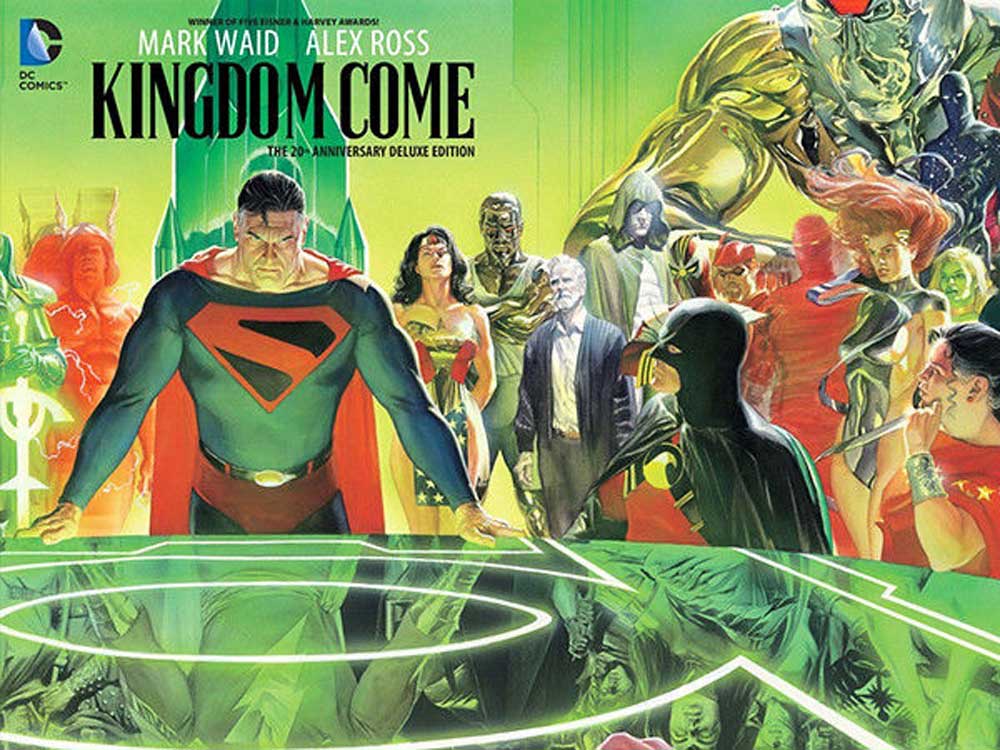Elderly Batman and Superman? That’s what DC Comics’ ‘Kingdom Come’ imagined 20 years ago
Published 10:59 am Wednesday, June 15, 2016

- The cover to the 20th anniversary deluxe edition of Kingdom Come from DC Comics. (DC Comics)
Twenty years ago, DC Comics looked 10 years ahead into the future and found a dark dystopia that would turn into an instant superhero classic.
“Kingdom Come,” a four part miniseries written by Mark Waid and beautifully illustrated by Alex Ross back in 1996, asked what happens when the next generation of superheroes doesn’t live up to the standard set by their predecessors, and the consequences of that failure. The story, which hints at dark days devoid of happy endings, remains one of DC Comics’ great accomplishments. As DC once again reboots its superhero comics with its current “Rebirth” event, “Kingdom Come” shows how greatness can come from reimagining its universe.
In the future-based story, which Waid considers a “cautionary fable,” Superman is graying at the temples and has turned his back on humanity after the death of Lois Lane. Batman is so old and broken from a mortal life of crime-fighting he’s become more machine than man, relying on technology to keep up the fight. An ageless Wonder Woman must be the voice of reason. An adult Captain Marvel fails to balance the responsibility of being both a man and a god and falls victim to those that would use him as a weapon.
Waid was put in charge of crafting the dialogue of “Kingdom Come,” but Ross helped put together the core plot points in pre-production meetings at DC Comics. When Waid first saw the initial plans Ross had put together, “I saw he’d hit a note that resonated with me,” Waid says.
The ’90s was an age when comic book heroes were expected to be darker and more extreme than those that had come before them, and Ross’s plan was “a rejection of the cynical, edgy superhero revolution of the 1990s,” Waid says. “We both felt and, I’m sure, still feel, that there are certain moral imperatives that are eternal, most of them summed up into the form of a man from Krypton.”
On working with Ross on “Kingdom Come,” Waid adds, “it was unlike any collaborate experience because it was so fraught with emotion and passion.”
The two didn’t always agree on plot points, both at times stubbornly passionate about DC’s heroes and how they should be portrayed. Ross says working with Waid on “Kingdom Come” was at times a clashing of two encyclopedic minds when it came to the history of the DC Comics universe. Waid jokes that he and Ross were the only people in the industry who would get in a screaming match about the Martian Manhunter. Both feel that their compromises on disagreements resulted in the best possible story.
“We were a tough fit back then, and we both had strong personal views about how to interpret our love for DC’s characters into this kind of combative story,” Ross says. “Mark and I weren’t two people who knew each other before, but we had to hit the ground running in working together. Luckily it seems this work benefited from that tension since it is still talked about to this day.”
Many comic book fans discovered Ross’s unique style from reading “Kingdom Come.” “A huge part of the appeal … was that no one had ever shown you the DC universe the way Alex did, mixing photorealism with bombast,” Waid says. “Alex was a visionary painter in a world of line drawings. His work is still as powerful, still as bold, but the way it opened a door for so many other storytellers to follow in his wake suggests to me that its influence is as mighty as its then-immediacy.” The artwork allowed the reader to think that this is what superheroes would look like in the real world.
In addition, seeing Ross’ older Superman with his trademark “S” accented with black instead of yellow signified a change in tone: Superman was wearing his anger on his sleeve.
Ross says, “The origin for most of my futuristic looks was to look to the different characters’ pasts to pull something out to focus on, as in a different style of costuming or way of drawing them, as my Superman was simply a retread of the Joe Shuster original/Max Fleischer cartoon version with the black logo.”
One of the biggest moments in “Kingdom Come” is an all-out battle at the end that features a showdown between an older Superman and an in-his-prime Captain Marvel. The moment produced an incredible page of art by Ross that features Captain Marvel towering over Superman with a smile that suggests he knows the Man of Steel is no match for him.
It’s a moment that almost didn’t happen, according to Waid.
“In our original talks, (Captain) Marvel was nothing more than a side player,” Waid says. “It wasn’t until after we realized he was the perfect fulcrum character to symbolize the bond between humanity and super-humanity did he become a key player, and thank God, as Alex’s rendition of the Big Red Cheese remains my favorite since the 1940s.”
Ross says the reason “Kingdom Come” still stands out today is that it is a great graphic novel meant to be just that, a great graphic novel. Nothing more. Such simplicity is no longer possible in the DC world, because of Hollywood’s continued interest in superhero comics.
“The production of films based on comics properties has not only overshadowed what happens in print, but it seems to more immediately influence and guide where creativity goes,” Ross says. “The creator’s autonomy in making a graphic novel or comic series be special on its own merits for that medium alone is now always affected by how well it seems to have a future for film/TV adaptation. The companies we work for as well as creator-owned publishing all have this in mind as a chief goal. Prizing the unique works that exist simply to be read is devalued.”
Twenty years later, Ross and Waid still cross paths. Waid, known most recently for his runs on Archie and Daredevil, is currently writing Avengers, a series for which Ross provides the cover art.
And their mid-90s look into the future of DC Comics remains a cherished, impactful project.
Ross says, “The satisfaction of knowing that work I’ve done has resonated with readers is really as much as I could hope for.”
Author Information:
David Betancourt writes about all aspects of comic book culture for The Post’s Comic Riffs blog.
(c) 2016, The Washington Post · David Betancourt · ENTERTAINMENT · Jun 15, 2016 – 10:37 AM






